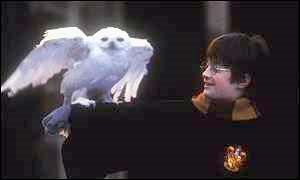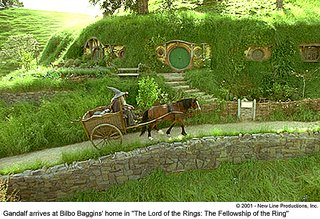Computers in Film
To start off, I'd like to say I would love to do more blogs like this, it's really interesting. It's hard to write most of my findings in my own words because the things I find are written so well as they are, so most of the things I found are in similar words to the website.
I absolutely love movies; it's a second passion of mine next to music. Harry Potter, Spiderman, Lord of the Rings and the classic Back To The Future films all use spectacular special effects. Although all of the movies listed are favorites of mine, I would like to focus my special effects analysis on the Harry Potter movies.
Rob Legato is part of the cutting edge of motion pictures, the wizards of computers and graphics and who create all-new worlds or recreate ones that have long since passed into history. There were more than 700 visual effects shots in Harry Potter and the Sorcerer’s Stone. Among the items that were achieved digitally: Quidditch matches and all broomstick performances, The Fat Lady-a plain cardboard cut out of her was used in filming at Gloucester Cathedral and actress Elizabeth Spriggs was added in post-production, The Mountain Troll, The Sorting Hat, Lord Voldemort, Hogwarts-related items-animated paintings, flocks of owls bringing mail, performances of magic, Hedwig (Harry’s owl) and other owls.
 Harry Potter and Hedwig (the owl)
Harry Potter and Hedwig (the owl)
Below are a few paragraphs explaining the creation of the visual effects of the game ‘Quidditch’ in Harry Potter.
QUIDDITCH (http://www.angelfire.com/mi3/cookarama/legato.html)
Legato told Apple Computer's Hot News that to put Quidditch on the Screen required his team to invent the framework of a nonexistent sport and shots of constant motion.
He said, "My view of attempting the Quidditch sequence was to create a visual effects action scene in a live-action, organic way. When you read the book, it's pretty wide open, and we had 11 minutes of unscripted material to create. You have to imagine a game, what its rules might be, how you might play it. You have to picture Quidditch in motion; you can't picture it as a photograph or a still or even as a series of storyboard frames, because the game moves too quickly."
A combination of actors flying on brooms on wires against blue screens and computer-drawn Quidditch field, stands and players was used. To design the sequence, the effects team had to imagine how Quidditch players would behave and plan their movements in advance. "We designed the sequence as if it were a live game. How would one action affect the next one? How would this player attack? How would that player get out of a tight spot? The goal was to realistically portray a series of events."
A special effects company named the Framestore CFC worked on the rest of the Harry Potter movies after the Sorcerer’s Stone including the most recent Harry Potter movie “Harry Potter and the Goblet of Fire”.
On the website I found :
(http://www.framestore-cfc.com/feature/harrypotter_goblet/) it explains that one of the biggest challenges in Goblet of Fire was the under water sequence. “The Framestore CFC team did such an amazing job that you really believe you're swimming with Harry in this mysterious yet beautiful underwater world, even though it only existed in the computer.”
Having already triumphed with creatures created for previous Potter films (the Basilisk and the Hippogriff, to name two), Framestore CFC was once more asked to participate in the film. The company faced some of the toughest challenges yet thrown at it by a series that has consistently raised the bar on cinematic digital visual effects. Framestore CFC delivered over 200 shots for Goblet of Fire, including an amazing underwater sequence, a carriage drawn by seven Pegasus-like creatures, and a quill pen with its own character and wit.
The length of the sequence delivered over 6 minutes of underwater footage. When you add in the facts that it was all CG (blue screen acting excepted), with everything moving and even with the medium through which you are looking at the action consisting of CG water with its distortions and floating particles. This consists of huge quantities of data and geometry.
The shoot for the sequence took place over several weeks, largely at Leavesden Studios. Says Tim Webber, "We shot what we could in the way of underwater blue screen material of the actors performing in a tank, but there were all sorts of limitations placed on them by the demands of the script and the environment. For instance, even with divers in the tank supplying Daniel (a.k.a. Harry Potter) with oxygen prior to the camera's rolling, we'd still have to wait for the bubbles to clear the shot before action could start, which cut into his available acting time. So, in addition to creating every single element of the underwater environments, we also had to create a CG Harry to carry out some of the action - and not just in long shots."
Framestore CFC's work began with the creation of the enormous, multi-tiered platforms that are both the location from which the competitors start the Second Task, as well as the site from which the spectators watch. The aerial shot was created entirely on the computer and introduces these structures. CG constructs in composited
The fact that Framestore CFC had to compose and implement every single aspect of these shots called for a much greater degree of creativity and artistry than is normally expected from VFX teams. "Getting the atmosphere - the sense of buoyancy and fluidity, for example, both in the visible elements and in the camera moves themselves, were crucial in these scenes," says Max Solomon, one of the team's two Animation Supervisors.
As well as Harry, CG versions of the four unconscious victims and the Krum-Shark were also required. Out of the CG creatures, the Grindylows were the most challenging, not least because there are more than 100 of them on screen in some shots. Automated 'cycles' were used in a limited fashion, as much of the Grindylow movement as possible was carried out using hand animation. One tool that proved highly useful was the in-house 'Choreographer' software. This was originally developed in tandem with the Charlie and the Chocolate Factory team who needed something that would help bring large numbers of squirrels to the screen. The software was further developed and refined by the Goblet team to assist them in their Grindylow wrangling.
Looking back on 18 months work - from first conversations to final delivery - spent by 130 Framestore CFC artists and technicians, Tim Webber is philosophical. "The biggest challenge," he says now, "Was the sheer number of big challenges."
Special effects for Lord of the Rings was a little different and I think more detailed oriented. The special effects team had to create whole landscapes; "Middle Earth", "The Shire", among other areas. "Putting contours into J R R Tolkien's Middle Earth hasn't just been the job of the locations in the New Zealand landscape where the three Lord of the Rings films are being made. It has also been the task of the special effects team at New Zealand's Weta Digital. "New Zealand is not always a substitute for Middle Earth," explains Weta Digital's chief technical officer, Jon Labrie. "Sometimes it's a composite of a number of different areas all kind of painted together."
The main photography for all three of the Lord of the Rings films took a little more than a year, finishing at the end of 2000. But the special effects work for the first film, The Fellowship Of The Ring, ended just last month. Tens of thousands of prints for the first film are now being made, ready for the December 19th public release of the movie. In the first film of the trilogy, Weta Digital produced 570 special effects shots.
Some shots were in production for months. Creating a scene such as the destruction of the Isengard, wizard Saruman's stronghold, used both computer graphic skills at Weta Digital, and the physical effects team at Weta Workshop. First, a complex miniature of Isengard was built, a detailed painting provided the background; and Weta's Massive software populated the scene. To handle the film work, the number of digital artists crammed into Weta Digital's Wellington buildings almost doubled in the 12 months to October this year, from 90 to 160 by the time the first film was finished.
From what I read on the websites, Lord of the Rings took a lot more special effects than Harry Potter and it took longer to make the film. I really admire the special effects artists for making the effects so seamless and real.
 Isengard
Isengard  Saruman
Saruman












0 Comments:
Post a Comment
<< Home